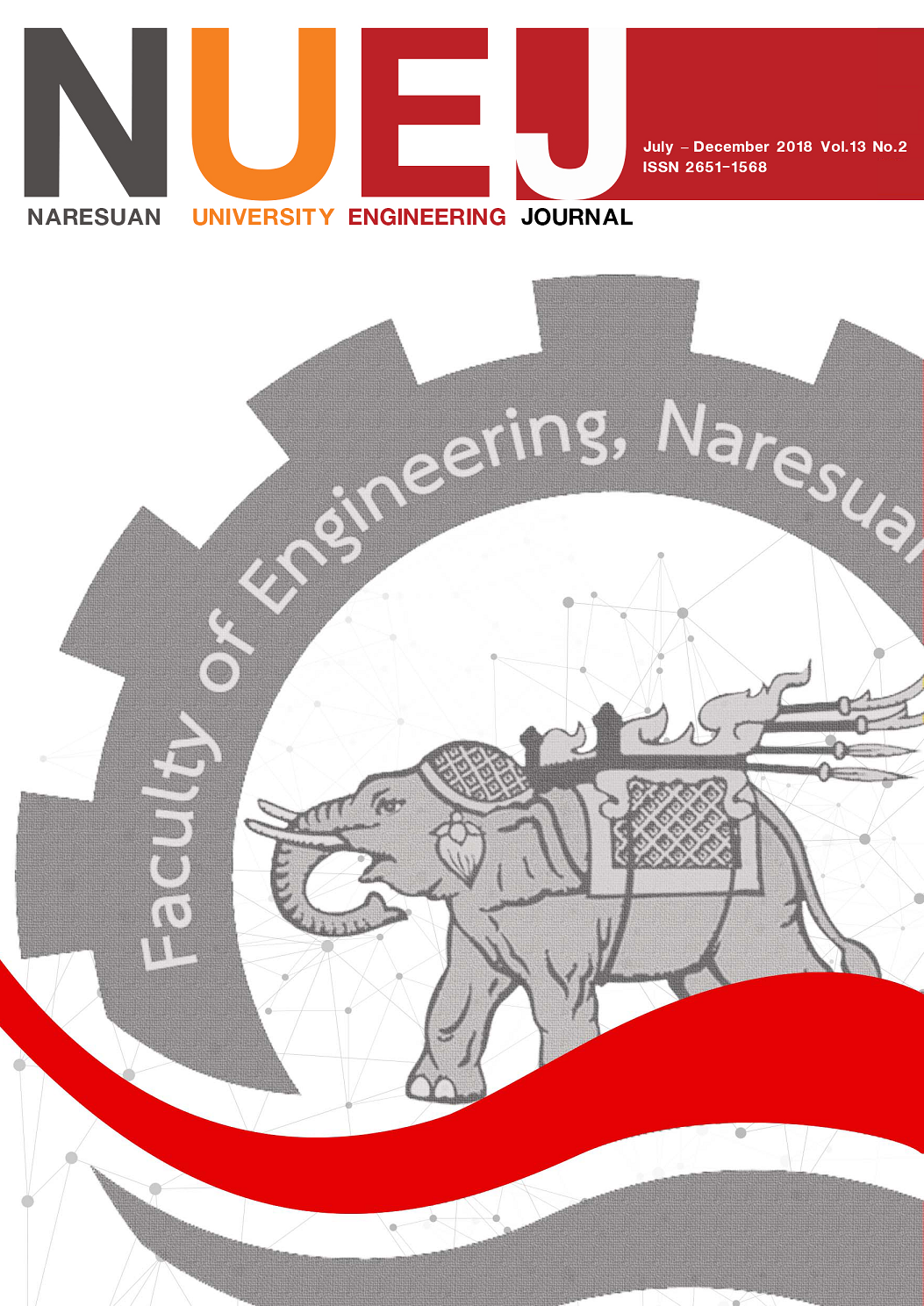The Assessment of Life Cycle Greenhouse Gas Emissions for the Fresh Rice Noodles in Amphoe Muang Phitsanulok Province
Main Article Content
Abstract
The objective of this research is to evaluate the greenhouse gas (GHG) emissions of two fresh rice noodles: wide rice noodles and rice stick noodles, which are studied in amphoe muang, Phitsanulok Province. From the results, the GHG emissions of wide rice noodles and rice stick noodles are 0.650 and 0.709 kg CO2 eq/kg of noodles. The orders of average GHG emissions from high to low for each stage are as follows: rice cultivation (50%, from methane emission 40%), noodle production (42%, from vegetable oil 17% and cassava starch 15%), consumption (2%), rice milling (2%), disposal (2%), and transportation (2%). The study suggests that the short period of drainage water from paddy field during the tillering stage and pre-harvesting stage could reduce the GHG emissions from the cultivation stage by 20%. The reduction of raw material compositions would help reduce the GHG emissions in the production stage but this would affect on the quality and quantity of noodles. Other possible ways to decrease the GHG emissions include improvement of production and energy efficiency by using rice husk as a renewable energy source, reusing condensate water, insulation covering of steam equipment, and blowing down the boiler to reduce the accumulation of slag.
Article Details
References
[2] Mungkung, R., Gheewala, S., Poovarodom, N., & Towprayoon, S. (2010). Carbon footprint analysis and management of rice products for carbon label to promote low-carbon economy for climate change mitigation. (in Thai)
[3] Cholathat, R. (2015). Climate change and potential solutions. Journal of Social Sciences Srinakharinwirot University, 416-431. (in Thai)
[4] OPM. (2016). National economic and social development plan, 12 edition 2017 - 2021, Office of the Prime Minister (OPM). (in Thai)
[5] Curran, M. A. (2013). Life Cycle Assessment: a review of the methodology and its application to sustainability. Current Opinion in Chemical Engineering, 2(3), 273-277. doi: 10.1016/j.coche.2013.02.002
[6] Fritsche, U. R., & Eberle, U. (2009). Greenhouse-gas emissions from the production and processing of food.
[7] TGO. (2015b). Dried rice noodle for 1 kilogram. Retrieved June 12, 2018, from https://thaicarbonlabel.tgo.or.th/products_approval/products_approval.pnc (in Thai)
[8] TGO. (2018). Carbon footprint of product: Registered Company and products. Retrieved 2018, June 12, from https://thaicarbonlabel.tgo.or.th/products_approval/products_approval.pnc (in Thai)
[9] TGO. (2015a). Guideline for the assessment of carbon footprint of product. Retrieved 2017, March 14, from https://thaicarbonlabel.tgo.or.th/admin/uploadfiles/download/ts_cb3d37071f.pdf (in Thai)
[10] TGO. (2016). Emission factor, Thailand Greenhouse Gas Management Organization (Public Organization). Retrieved March 19, 2017, from https://thaicarbonlabel.tgo.or.th/admin/uploadfiles/emission/ts_822ebb1ed5.pdf (in Thai)
[11] IPCC. (2006). 2006 IPCC Guidelines for national greenhouse gas inventories.
[12] DOAE. (2560). Rice production of Phitsanulok 2 for wet season rice in Thailand. Department of Agricultural Extension (DOAE). Retrieved January 20, 2018, from https://production.doae.go.th/report/report_main_land_01_A_new2.php?report_type= (in Thai)
[13] Phitsanulok Rice Research Center. (2012). Rice academic documents, 50-year Phitsanulok Rice Research Center: Rice Department. (in Thai)
[14] Klein, C. D., Novoam, R., Ogle, S., Smith, K. A., Rochette, P., Wirth, T. C., . . . Williams, S. A. (2006). IPCC guidelines for national greenhouse gas inventories, Volume 4: Agriculture, forestry and other land use, Chapter 11: N2O emissions from managed soils, and CO2 emissions from lime and urea application. from https://www.ipcc-nggip.iges.or.jp/public/2006gl/pdf/4_Volume4/V4_11_Ch11_N2O&CO2.pdf
[15] Klein, C. D., Novoam, R., Ogle, S., Smith, K. A., Rochette, P., Wirth, T. C., . . . Williams, S. A. (2006). IPCC guidelines for national greenhouse gas inventories, Volume 4: Agriculture, forestry and other land use, Chapter 11: N2O emissions from managed soils, and CO2 emissions from lime and urea application. from https://www.ipcc-nggip.iges.or.jp/public/2006gl/pdf/4_Volume4/V4_11_Ch11_N2O&CO2.pdf
[16] JGSEE. (2012). Greenhouse gas emission database from agricultural sector The Joint Graduate School of Energy and Environment (JGSEE). King Mongkut's University of Technology Thonburi. (in Thai)
[17] Kalsirisin, R. (2002). Agricultural machinery 2. Retrieved August 3, 2017, from https://www.arda.or.th/kasetinfo/rice/rice_product/rice-product4_1.html (in Thai)
[18] Amornchaisup, S. (2002). Energy consumption for rice milling and cooking. Master's thesis. King Mongkuts University of Technology Thonburi. Retrieved from https://www.thaiscience.info/Article%20for%20ThaiScience/Article/3/10014147.pdf (in Thai)
[19] Ekasilp, W., Soponronnarit, S., & Therdyothin, A. (1995). Energy analysis in rice mills for cogeneration in Thailand. Kasetsart Journal, 29, 87-99. (in Thai)
[20] MOE. (2016). Thailand energy balance manual, Ministry of Energy (MOE). (in Thai)
[21] Sampattagul, S., Kongboon, R., & Prathumthong, U. (2014). Carbon Footprint Management for Food Industry. (in Thai)
[22] DIW. (2003). Practice for pollution prevention (Cleaner Technology), Noodle industry Department of Industrial Works (Diw). (in Thai)
[23] Anawong, J. (2017). [Personal communication. April 3 2017]
[24] Kohkhoo, R., Chaichana, N., Chai-arree, W., Pornprom, T., Malumpong, C., & Pakoktom1, T. (2015). Methane emissions from water and weed managements in irrigated paddy rice field. Proceedings of 53rd Kasetsart University Annual Conference: Plants, Animals, Veterinary Medicine, Fisheries, Agricultural Extension and Home Economics. Retrieved September 9, 2018, from https://kukr.lib.ku.ac.th/proceedings/KUCON2/search_detail/dowload_digital_file/315145/89600 (in Thai)
[25] Chomkaew, S. (2013). Effect of fertilizers on greenhouse gas emission in paddy field. Master's thesis. Chulalongkorn University. (in Thai)
[26] Phraprasert, P. (2000). Effects of rice varieties and nitrogen fertilizers on methane emission Master's thesis, Kasetsart University. (in Thai)

